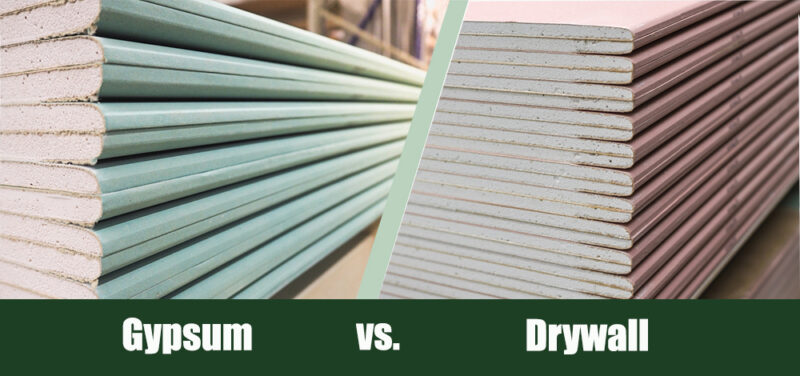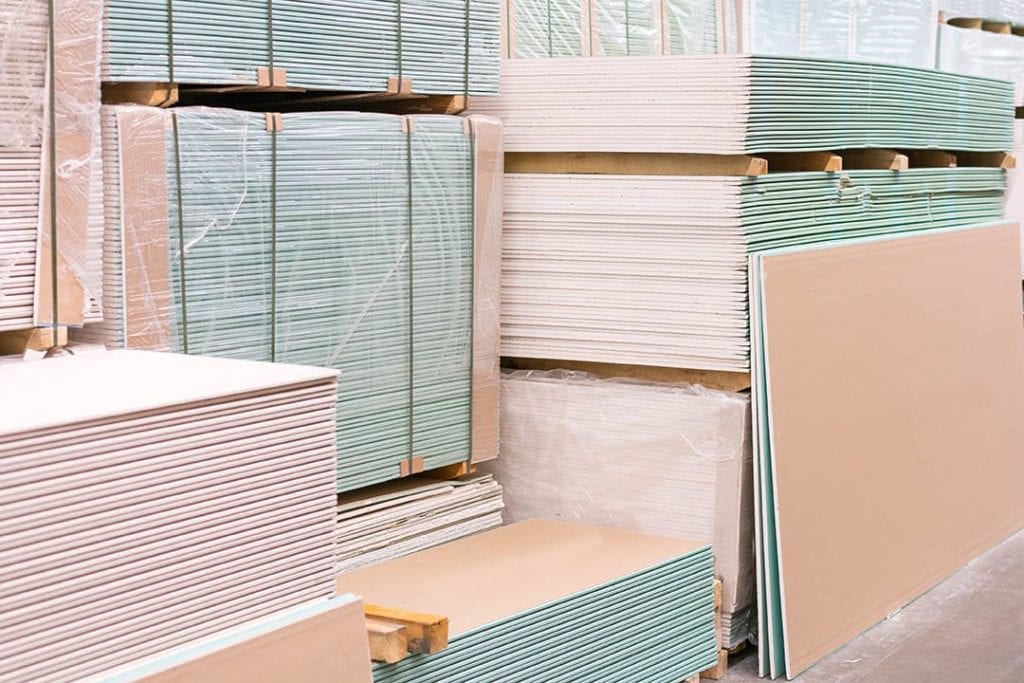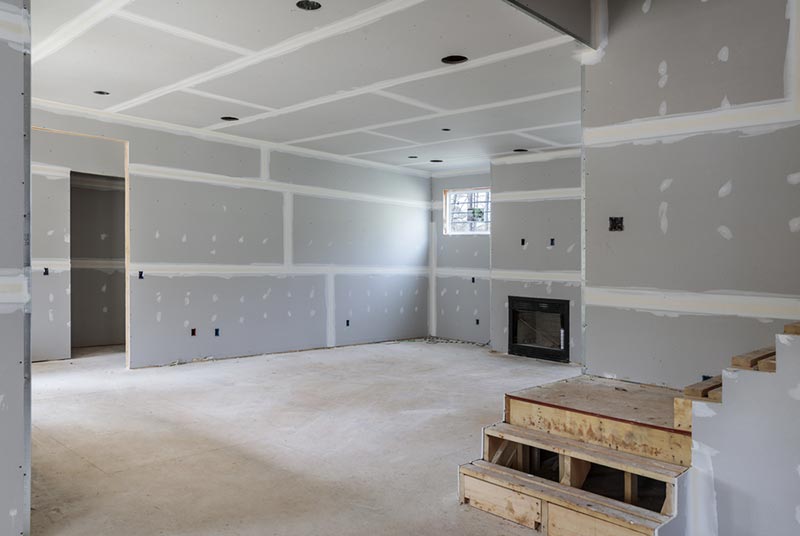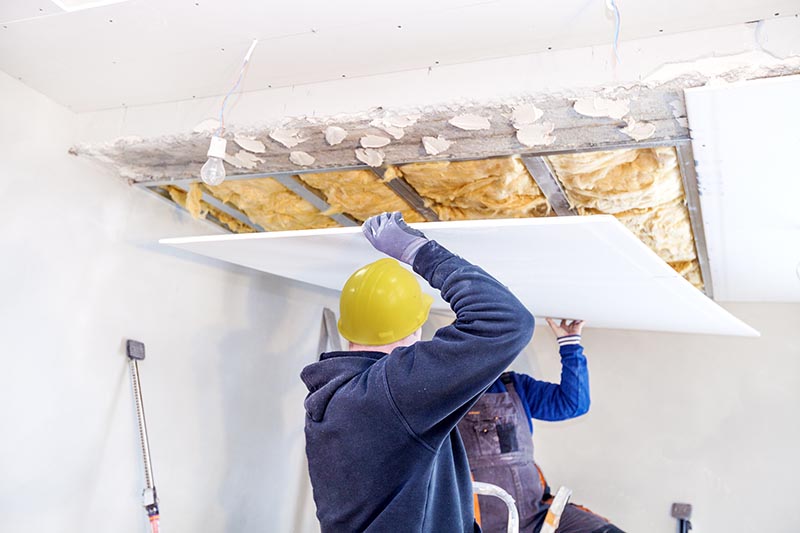Gypsum vs Drywall: Differences Explained (With Pictures)
-
- Last updated:

When finishing your new construction, you will likely face the task of walling between the studs and finishing the ceiling. In the construction industry, you can use two types of boards on your walls and ceiling: drywall and gypsum.
While both can serve the same purpose, they’re not made the same way. There are practical differences between the two. Each product also has its unique set of characteristics and properties. Gypsum occurs naturally, while drywall is artificial.
Understanding these differences will help you know how to use each one and make an informed decision when choosing. In this article, we’ll review the differences between drywall and gypsum to help you understand which one is best for your construction project. Keep it here to learn more!
Click to Jump Ahead:

Overview of Gypsum

Gypsum is a mineral with a chemical composition of CaSO4*2H2O, used in many products. You can use it as a building material or making Plaster of Paris and wallboard. Gypsum also has many other uses such as in making paper, fertilizer, and salt.
But, in this handy guide, we’ll focus on gypsum used in building and construction. The gypsum has outstanding properties that make it helpful in building and construction.
Here are some of them:
Fire Resistance
Gypsum won’t burn or melt like many other building materials when exposed to high temperatures. It’s an excellent choice for use in areas where fire protection is needed, such as electrical rooms and storage areas. It can withstand extreme heat, thus an ideal material for fireproofing applications.
When applied to structural elements such as concrete beams, columns, and walls, gypsum protects against fire for up to three hours. It’s enough time for firefighters to control a blaze before it spreads.
Acoustic Properties
Gypsum is an excellent sound absorber and barrier against sound transmission. It’s crucial because it can help dampen noise from traffic and other sources outside the building. The acoustic properties of gypsum are also helpful in reducing noise generated in the building. They reduce echoes and reverberation.
This makes it an ideal choice for use on ceilings in houses or offices where you need privacy from outside sounds like traffic noise. For higher acoustic performance, incorporate an air space between two gypsum walls.
Thermal Properties
The thermal conductivity of gypsum is low compared to other building materials such as steel or aluminum. It’ll not transfer heat as fast as these materials when exposed to heat sources such as fire or sunlight.
This low thermal conductivity also means that gypsum will not conduct cold well either. It makes it an ideal material for insulating buildings with large temperature fluctuations during the year.
Ductility
Ductility is the ability of a material to be stretched or drawn into a wire-like form without breaking or cracking. Gypsum can be cut into different shapes or sizes, thus making installation easier.
It also means that if any cracks or holes form in your walls, you can just patch them up. You don’t have to replace entire sections like you would with concrete or stone walls.

The 5 Different Types of Gypsum
Gypsum is one of the most abundant minerals in the earth’s crust. You can find it in many different types, each with unique properties. Here are several types of gypsum used in building and construction.
1. Gypsum Fireboard
Fireproof gypsum boards are the core materials in lightweight concrete construction systems. They are also used as a fire-resistant lining material in steel-reinforced concrete structures.
It’s made from natural gypsum-based raw materials. It has high strength, durability, and low thermal conductivity characteristics. It’s soundproof and shock- and humidity-resistant. You can also use a gypsum fireboard for wall linings, roofs, and floors.
2. Plasterboard
The primary use of gypsum is in the production of plasterboard. This product consists of gypsum mixed with water and pressed into sheets. You can use plasterboard to make walls, ceilings, floors, and for partitioning.
Plasterboard is a versatile product you can cut down to size and put together if you have basic DIY skills. Besides, it is non-combustible.
3. Gypsum Plaster Blocks
Plaster blocks are made from gypsum and a binder. They are used for interior walls and ceilings. You can cut and shape them easily using standard tools. Besides, you can install them fast and easily. These plaster blocks have a smooth surface for painting or staining. They are also resistant to fire and mildew but can be damaged by water leaks or high humidity.
4. Decorative Plaster (Plaster of Paris)
This is a dehydrated plaster powder dissolved in water. You can use it to line ceilings and brick walls. It’s also ideal for beautiful decorations. Traditionally, this decorative plaster was used as an interior wall covering. These days, it makes sculptures and other decorative items.
The most common decorative plaster is called the “plaster of Paris.” It consists of gypsum powder mixed with water until it reaches the desired consistency. Plaster of Paris is found worldwide and gets its name from Montmartre in Paris. It’s a large gypsum deposit.
5. Gypsum-Based Self-Leveling Screed
It’s the most commonly used form of gypsum screed. It’s made from a blend of mineral fibers, water, and additives. They work together to give you a strong, durable, and flexible material you can cut, mold, and shape.
Leveling screeds are available in standard grades or high-strength versions for larger areas. You can use them for internal and external applications with an appropriate finish applied to the surface. If you want a level floor before installing tiles, the gypsum-based self-leveling screed is your best bet.

What Is Gypsum Good For?
Gypsum (also known as calcium sulfate) has many uses in the home. It’s used to make drywall. It’s cut into thin strips, which are applied to cover walls or ceilings with drywall compound or plaster of Paris.
Gypsum has been used since ancient times as a building material and for making statues and other objects. It was also used to produce paper until the early 20th century. Today, gypsum makes drywall (sheetrock) for walls and ceilings.
- Eco-friendly
- Balances indoor atmosphere
- Fire-resistant
- It has a smooth surface
- High acoustic and thermal insulation
- Excellent aesthetics and functional features
- Easy installation
- Low shelf life
- It doesn’t work well against water
- Expensive
- Low durability

Overview of Drywall

Drywall is a generic term for wallboard or sheetrock. It’s composed of gypsum plaster. It’s a fibrous material that can be cut, sanded, and textured to create an interior wall surface. Drywall’s properties make it an excellent choice for interior wall and ceiling finishes.
Here they are!
Fire Resistance
Drywall is rated according to its Fire Resistance Rating (FRR) number on each sheet. In most residential applications, the FRR rating is three hours. A piece of drywall will not burn through in three hours. So, drywall is considered not combustible thanks to the gypsum in it.
However, fire resistance does not entirely mean that it is foolproof. It may be weakened by heat and flames during that time. So, never cover your walls with drywall if exposed to direct flame or heat sources such as wood stoves or space heaters.
If you want to increase drywall’s fire resistance, partition using two drywall sheets. The cardboard between the two drywall sheets can provide fire resistance for an extended period.
Acoustic Properties
Drywall provides excellent sound control. The dense layer of gypsum plaster absorbs sound waves. It also reduces noise transmission through walls and ceilings, preventing outside noise from coming into your home.
Thermal Properties
Drywall has excellent thermal resistance than other materials used for interior wall finishes. It has a high R-value (Resistance to Heat Transfer). Usually, it’s specified to have an R-value of 0.5 per half-inch thickness. It’s greater than other construction materials. The R-value will vary depending on the type of drywall.
Ductility
This is the ability of drywall to flex without breaking. Drywall is made from gypsum and fiberglass, which are brittle materials. But when mixed and compressed during manufacturing, they become ductile.
Drywall can also withstand tensile stress without breaking apart. But, it does not perform well under compression stress, which causes it to break apart easily. This property means that you should take care when using tools that may cause undue strain on your drywall.
You can alleviate this problem by adding steel framing to the interior of the drywall sheets, but this solution needs more work.

The 5 Different Types of Drywall
Drywall comes in different types to suit various construction types. Here are some types worth considering.
1. Mold-Resistant Drywall
This drywall is treated with a mold-resistant additive that inhibits the growth of mold and mildew. Install mold-resistant drywall in areas with excess moisture or humidity, such as bathrooms and kitchens- it prevents mold damage during periods of high humidity. You can also use it on walls adjacent to plumbing pipes or electrical wires.
2. Regular Drywall
Regular drywall, also called whiteboard, is the most common type of drywall. It’s made from gypsum, a naturally occurring mineral mined from rock formations, crushed, and processed into sheets.
The sheets are sanded and glued together with paper-based tape to make panels ranging from 4 by 8 inches to 10 by 14 inches. The surface of regular drywall is textured and covered with a thin layer of plastic called vinyl plastic or paper tape. It protects it from staining and moisture damage.
3. Soundproof Drywall
This drywall is made from a special gypsum board that reduces sound transmission. It has a layer of sound-deadening material on the back and comes in two different thicknesses. The most common type is 5/8-inch thick, which provides good sound absorption. But, the ½-inch version offers even better results.
You can use soundproof drywall if you need extra soundproofing. So, you can install it between shared walls or living spaces. It’s denser than ordinary drywall and is more challenging to work with.
4. VOC-Absorbing Drywall
This is a gypsum board that absorbs Volatile Organic Compounds (VOC) in the air. It contains chemicals that control harmful fumes emitted by paint or other products. Installing this drywall can reduce VOC levels in your home if you have allergies to these chemicals.
5. Fire-Resistant Drywall
Fire-resistant drywall contains fire-resistant fibers that can withstand high temperatures. It is less flammable than standard drywall. It comes in two types: Type X and Type C. Type X will give an hour of fire protection. It’s 5/8 inches thick. Type C is similar to Type X, but it doesn’t shrink if burned.

What Is Drywall Good For?
Drywall has many uses in homes. It’s one of the most common materials used in residential construction as well as commercial buildings, such as office buildings or industrial facilities. You can also use drywall to finish the inside surfaces of a basement or attic.
However, drywall is not ideal for use on the exterior of homes because it does not hold up well against moisture from rain or snow on roofs. It works well for interior applications. When installed, it has a smooth surface for painting or wallpapering.
Drywall is also ideal for wrapping columns and hiding steel beams. It’s considered the safest wall material in any building project.
- Can be painted easily
- Doesn’t need sanding
- Fire-resistant
- Excellent temperature and sound insulation
- Various types and sizes to choose from
- Costs less to buy and install
- The whole drywall surface has a consistent appearance
- Easy to remove
- Joints between the sheets become visible if not installed well
- Not moisture and water resistant
- Heavy
- Creates a lot of mess during the installation process
- Challenging to bend
- Recycling is challenging
- Not impact-resistant
- You cannot install it by yourself due to the complex work involved

What Are the Differences Between Gypsum and Drywall?
Drywall and gypsum are two of the most common building materials used in homes. They have their differences. So, how do you decide which one is right for your project? Let’s shed light on some differences between these two building materials.
Water Resistance
Drywall is made of gypsum mixed with Portland cement powder. It makes it more resistant to water damage than gypsum alone. Drywall is also more resistant because the gypsum is between two thick paper sheets.
Drywall is ideal for bathrooms. It’s more moisture-resistant than other wallboards, such as paperboard or plywood. Gypsum absorbs moisture. So, don’t install it in rooms with high humidity.
Versatility
Drywall is more versatile than gypsum. You can use it for interior and exterior walls and ceilings. Gypsum is only suitable for interior walls.
Working with drywall is also easier than with gypsum. You can cut drywall into different sizes and shapes. The drywall boards fit together perfectly. It’ll also be easy to fill their joints. On the flip side, the complex installation procedure of gypsum restricts its uses.

Cost
The cost of buying drywall and gypsum is similar. The only cost difference is installation. Installing drywall is easy and doesn’t need skilled labor. It makes it cost less than installing gypsum.
Gypsum installation needs a lot of skill to do right. It means you must hire a professional to install it for you. Besides, gypsum installation will also take a lot of time. That means installing it is more expensive than drywall.
Longevity
The surface of drywall is made of paper, making it less durable than gypsum. Gypsum is harder than the sheets of paper used to manufacture drywall.
Ease of Repair
You can repair drywall by replacing or patching the damaged material. Patching involves attaching new material over the damaged area. You will fasten it using a joint compound, sand it, and repaint it.
On the other hand, repairing gypsum is easier since it’s made of the same material. You don’t need to pass through the cut-out phase.
Gypsum vs Drywall: Which One Is Right for You?
Using drywall or gypsum in your construction project depends on your preferences and where you’re installing it. If durability is the primary factor in your project, you can opt for gypsum. Remember that gypsum needs professional installation. So, it may cost you more in the long run.
On the flip side, if water resistance is the key factor you’re considering, go for drywall. It’s more water-resistant compared to gypsum. Besides, you can cut drywall to your preferred size or shape.

Conclusion
It’s interesting how much the two materials have in common, yet how different they are. From special uses to the basic construction process, gypsum and drywall have a lot in common. They are versatile, depending on the application.
You can improve any room with either of these products, but one may work better than the other. Before starting any remodel or construction project, research and understand what will work best for you.
The bottom line is that they both achieve the same purpose: providing a finished wall or ceiling surface with minimal effort. The choice between gypsum and drywall will come down to more than just cost but personal preference.
Featured Image Credit: (L) Stanislav71, Shutterstock | (R) Viktor Fedorenko, Shutterstock
Contents


